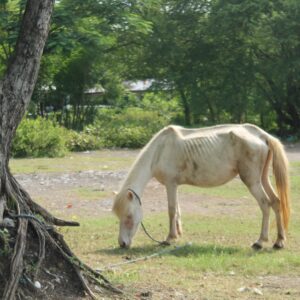 Proceed Carefully: Feeding Neglected Horses. For many horsemen and horsewomen, nothing proves more heartbreaking and maddening than seeing horses in neglectful situations. Especially when there’s little to eat or drink. Those that dedicate their time and resources to rehabilitating these horses know well the need to refeed horses carefully, almost exactingly.
Proceed Carefully: Feeding Neglected Horses. For many horsemen and horsewomen, nothing proves more heartbreaking and maddening than seeing horses in neglectful situations. Especially when there’s little to eat or drink. Those that dedicate their time and resources to rehabilitating these horses know well the need to refeed horses carefully, almost exactingly.
“Feeding a severely underweight horse can be complicated. It is best done under the guidance of a veterinarian, particularly if the horse has a body condition score of less than 3 on the standard scale of 1 to 9,” said Kathleen Crandell, Ph.D., a nutritionist with Kentucky Equine Research.
If the horse has been completely starved and has not eaten in days? The process of refeeding begins slowly and progresses gradually. This is counterintuitive to any nurturing personality. Most horse owners want to throw forage and feed at starved horses. However, a more precise feeding schedule has been outlined and adopted by many vets and caretakers.
Feeding Schedule:
According to Crandell, the feeding schedule would be:
- On the first three days, the horse will receive about 50% of its digestible energy requirement spread over six meals per day. (1–1.25 lb or 0.4-0.6 kg per meal for a horse that would weigh 1,000 lb or 450 kg as a desired weight.) Use alfalfa, mixed alfalfa/grass, or high-quality grass hay with free-choice access to water.
- On the fourth and fifth days, the amount can increase to 75% of the horse’s energy requirement in six meals per day (1.75-2.0 lb or 0.8-0.9 kg/meal) of the same forage.
- From the sixth to tenth days, the horse can get 100% of the digestible energy requirement reduced to three meals per day (up to 5 lb or 2.3 kg/meal) of the same forage.
- The horse should remain on high-quality forage for at least a month. Then some concentrate can be gradually added to the diet. Do not, however, add any concentrate feeds into the diet until body condition improves to a score of at least 3.5.
Added Support:
To support the healthy rebuilding of the ravaged body and digestive tract, a high-quality vitamin and mineral supplement should be fed. It is likely necessary to balance the nutrients that may be low or missing in the forage. A vitamin and mineral supplement with a recommended serving size of an ounce or two can supply the desired nutrients without added starch or sugar. Starch and sugar should be avoided at the beginning of refeeding.
“Return to normal weight may take three to six months to achieve, depending on the body condition of the horse at the time refeeding begins,” she said, “but slow, steady progress often yields the best results.”
This measured approach is the safest method of refeeding. Crandell understands, however, the lure of wanting to feed “fast and furious.”
“Too much feed or the wrong feed can have severe consequences. Even too much feed spread out into several meals a day will not benefit a severely underweight horse. This can cause a metabolic crisis that can result in death,” Crandell warned.
Negative Consequences:
Sudden consumption of too much concentrate, whether it’s a straight cereal grain or a commercial feed, causes a rise in glucose in the blood and a subsequent elevation in insulin. Insulin is the body’s cue to push glucose into cells. Unfortunately, in the case of starvation, the insulin will also drive electrolytes. For example, phosphorus, magnesium, and potassium, into the cell with the glucose. This causes instability between intra- and extracellular electrolyte balance.
When phosphorus is pushed out of the blood and into cells, researchers believe hypophosphatemia, or low blood phosphorus, results. Hypophosphatemia disturbs red blood cell metabolism and causes impaired oxygen delivery to the cells in the body. The heart and lungs, starved of oxygen, begin to fail. Called “refeeding syndrome,” in human medicine, this occurred in Word War II when prisoners were rescued from concentration camps and then given food, according to Crandell.
Horses in neglectful situations are usually in need of dental and hoof care, vaccinations, and deworming. As the horse gains strength through refeeding, seek advice from a veterinarian about when to best implement these basic health care practices. Some may be more important than others. If the teeth are characterized by points, malocclusions, or other problems, for instance, it will be hard for the horse to chew forage properly, thus precluding weight gain. In this case, getting the teeth tended to as soon as safely possible would be the best bet.
Resources:
In conclusion, do you have questions about Feeding Neglected Horses? Contact us at J & J Hay Farms by clicking here!
Article Sources: Kentucky Equine Research
Stull, C.L. 2011. Refeeding the starved horse. In. Wilson, D.A. (ed.) Clinical Veterinary Advisor: The Horse. Saunders. p. 788-790.
